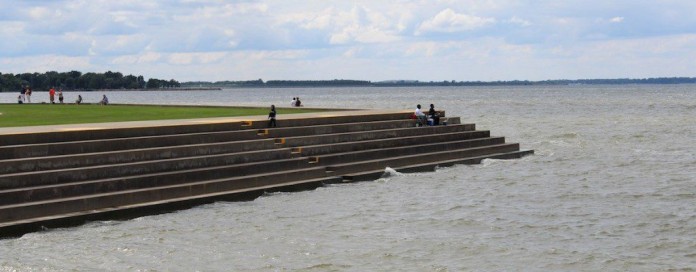During the first four days of August, the Western Basin of Lake Erie made national news.
A harmful algal bloom (HAB) threatened the water supply near Toledo, Ohio. Wind and water currents pushed a bloom of blue-green algae (cyanobacteria) to the city’s water plant intakes.
Toxins (microcystin is of greatest concern) produced by this algal bloom made the water undrinkable for several days. Microcystin can cause skin rashes, intestinal problems, nervous system, liver and kidney damage, so it is essential that it be removed before water is deemed safe.
To answer some of the questions about this phenomenon, I talked to Dr. Jeff Reutter, director of Ohio Sea Grant and Stone Laboratory.
SS: What is a harmful algal bloom?
JR: A harmful algal bloom is any large density of algae capable of producing toxins. In Lake Erie, those algae tend to be cyanobacteria or blue-green algae. They are always present in the water, but under certain conditions they grow excessively.
SS: What causes HABs?
JR: Warm water above 60 degrees F and high concentrations of phosphorus trigger blue-green algae blooms.
SS: Why is phosphorus important?
JR: Phosphorus, nitrogen and potassium are the major components of most fertilizers. If we fertilize our lawns, grass grows. If we fertilize crops, crops grow. And if we add fertilizer to water, algae grow. In freshwater, the single essential nutrient in shortest supply is phosphorus. So when fertilizers run off into freshwater, HABs can occur.
SS: How does phosphorus get into freshwater?
JR: Most phosphorus that enters Lake Erie originates in runoff from agricultural fertilizers and manure. Heavy rains wash soil and fertilizers into rivers and streams that eventually enters the lake. Some phosphorus also comes from sewage treatment plants, cleaning products, faulty septic tanks, and lawn fertilizers.
SS: Why did this HAB occur in western Lake Erie?
JR: The western Basin of Lake Erie (west of Sandusky, Ohio) is surrounded mostly by farmland. Furthermore, this part of Lake Erie is shallow (average depth of 24 feet) so its waters are warmer than those to the east. Combine warm water with high concentrations of phosphorus from fertilizers flowing into the lake from the Maumee and Sandusky Rivers, and HABs are predictable.
The Maumee watershed drains 4.2 million acres of farmland so its runoff is rich in phosphorus. The Central Basin of Lake Erie, from Sandusky to Erie, Pa., has an average depth of 60 feet and the Eastern Basin, east of Erie, is even deeper with a maximum depth of 210 feet. Because there’s more water in the Central and Eastern Basins, it stays cooler and HABs are less frequent, less severe, shorter lived, and smaller in size than blooms in the Western Basin.
The other four Great Lakes are larger and deeper (more than 750 feet deep), and their watersheds are primarily forest ecosystems so there is less agricultural runoff. That’s why HABs tend occur most frequently in Lake Erie, especially the western basin. Because Lake Erie is the southernmost, shallowest, warmest, and most nutrient-rich of the Great Lakes, it is the most biologically productive. In fact, Lake Erie produces more fish for human consumption annually than the other four Great Lakes combined.
But it is possible to have too much of a good thing. A little phosphorus makes Lake Erie the “Walleye Capital of the World,” but too much phosphorus can lead to harmful algal blooms.
SS: How is toxic microcystin removed from the water to make it safe to drink?
JR: Water treatment plants use activated charcoal to remove toxic substances from water. Toxins such as microcystin bind to the charcoal and are then filtered out of the water.
SS: Will conditions that caused this HAB move east to the Erie, Pennsylvania, area?
JR: That’s unlikely because of the greater volume of water in the Central and Eastern Basins and because there is less agricultural runoff there.
SS: Are Lake Erie fish safe to eat?
JR: The Ohio Department of Natural Resources reports that as long as fish fillets are properly cleaned and rinsed, they are safe to eat.













